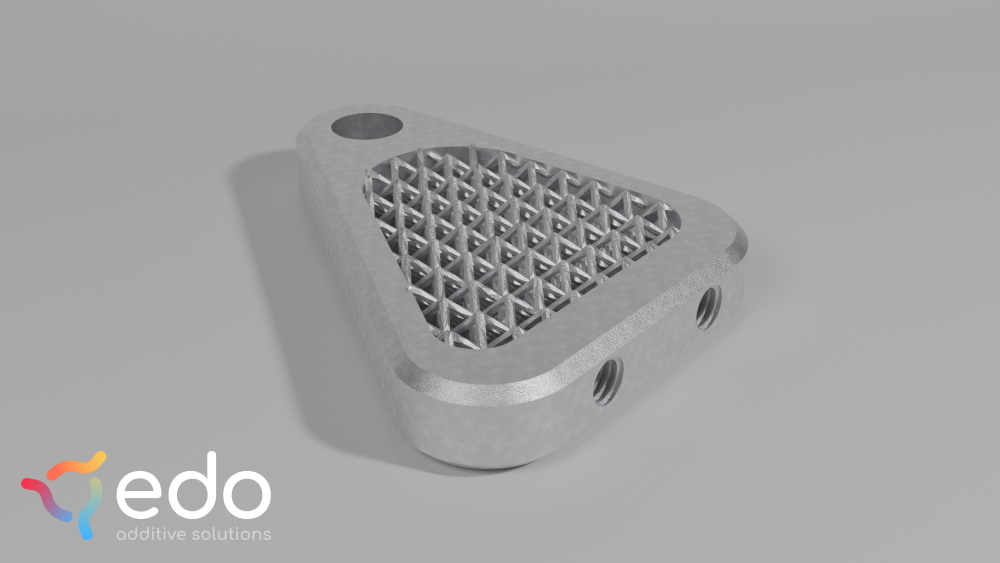Lattice Structures and their Applications

Introduction
Chances are high that you have seen some interesting-looking self-repeating structures in 3D-printed parts. Those are called lattices and are a feature usually only seen in 3D printed parts since manufacturing those traditionally is extremely difficult or just flat out not possible. Lattices can be used in many applications and usually serve multiple different purposes.
What are lattice structures exactly?
Lattice structures refer to geometric arrangements of points or structures in space that form a repeating pattern. In physics, lattice structures refer to the arrangement of atoms, ions, or molecules in a crystalline solid. This is also the inspiration for the structures mechanical and material scientists call lattice structures, the exact same structures we see in 3D printed parts. Lattice structures are a domain of engineered structures that try to mimic the strengths of crystals.

Typical Lattice Examples, from left to right: Gyroid, Cross Cell and 2.5D X-cell
The benefits of lattice structures.
Lattice structures bring some exciting properties by their design and help engineers improve the performance of parts. The most prominent use case of lattice structures is grading the material density. This enables engineers to reduce the amount of material where it is less needed and, therefore, reduce the overall weight. The less material to be printed, the lower the build time in most 3D printing processes will be. This reduces cost which ultimately will increase efficiency and make the part more competitive.
Another interesting, but not often used, aspect of lattice structures is the fact that it’s possible to engineer the material properties. Therefore, it becomes possible to make a lattice that is very stiff in one direction but quite flexible in others. Lattices can also help increase surface area to help heat exchangers, heatsinks and chemical reactors become more efficient by optimising the shape of the part.
Another helpful application of lattices is acting as support material that is not intended to be removed, saving the cost of labour to remove supports. Due to their often lightweight nature, they do not affect the part weight significantly, while they can still add a lot of strength.
Applications
The applications of lattice structures are not limited to any particular industry. Rather, there are industries and 3D printing technologies in which the usage makes more sense than in others.
Talking first about technologies, 3D printing technologies like FDM and LPBF where print time directly correlates with the amount of material used in the part, it makes a lot of sense to use lattice structures to cut in cost. In technologies where print time is not always directly related to the amount of material printed, like DLP 3D printing, it makes less sense. However, that doesn’t mean it’s useless to use lattices in these cases. It just needs to be justified with part weight, material cost, the specific application (heatsinking etc.) or a potential reduction in warping (depending on the technology). On the other hand, it also is not always a great idea to include lattices. Sometimes, getting rid of the unused material in between the lattice structure would get too complicated, or the weight of the part is needed, or the material in the part is required since strength needs to be maximised.
Talking about industries, typical industries that use lattice structures often are high-performance, low-weight industries like aerospace and racing. Medical applications are mostly interested in matching the strength of materials to the strength of human tissue like bones and maximising surface. Consumer parts and models are mostly interested in minimising material cost, building time, and making parts lighter to reduce ecological footprint and shipping costs. Here, lattices can help achieve these goals.

Simple 3D Printed Aluminium Bracket with Lattice Infill to Improve Printing Time
Conclusion
Lattice structures can often help parts become more efficient, even if they are not visible and are not an active feature of the part. The nice aspect of lattice structures is that many software packages include them nowadays to hollow out parts easily and replace them with lighter lattice structures. This is useful, especially for parts that are not under load like models for mechanical parts. However using those features might still affect the integrity of the part. However, in the right application and with the right usage by the engineer, lattices can not only become a visible feature as well but also help decrease weight and increase production speed or even become active elements of the parts, as in heatsinks and chemical reactors to improve performance. First and foremost, lattices are a structure and design element that is only available to 3D printing and bring parts to the next level.
We are an engineering firm with the target of solving your additive manufacturing difficulties with our state of the art knowledge from Stanford, MIT, ETH Zürich and many industrial partners. Just give us a call or write us here, and don’t forget to subscribe to our newsletter (1 email per week with AM insights).
The next releases will cover:
- Essential Design Rules for Mass 3D Printing
- 3D Printing In-house vs Contract Manufacturing
- How to Find the Right 3D Printing Process
- High-resolution 3D Printing (SLA/DLP)
- Holistic Benefits of 3D Printed Parts

A lattice structure that greatly reduces weight and print time while maintaining stiffness
Subscribe to our newsletter to learn more about additive manufacturing.